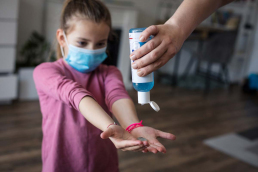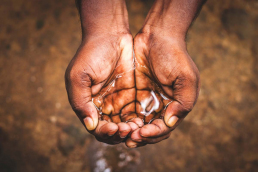Corona Pandemic and Water Value
What if the water suddenly doesn’t come out from the tap? What will happen to our life? It will be hard to prevent the coronavirus that hit the whole world.
Hygiene and water

To contain the spread of COVID-19 and many other infectious diseases, it is critically important to clean your hands regularly with water and soap or alcohol-based hand rub.
Until just 170 years ago, many people thought infections were caused by foul, polluted air or ‘miasma’. In the mid 19th century, physician Ignaz Semmelweis discovered how microbial infection works and found that hand washing with soap dramatically reduced the spread of deadly diseases.
Since then, the world has been pioneering the hygiene activities through hand washing. The Center for Diseases Control and Prevention named washing hands as “do-it-yourself vaccine” in the sense of autovaccination.
Therefore, now that the COVID-19 pandemic requires thorough hygiene management, the value of “water,” an essential resource directly connected to hygiene, is higher than ever. Water is essential for all mankind and living things, but it is not inexhaustible.
The amount of water available on the earth

The total amount of water on earth is about 1.38 billion㎦ [about 365 trillion gallons]. Assuming this is 100%, 97.41% is the seawater and 2.59% is freshwater. Of the freshwater, 1.984% is frozen as glaciers or icebergs, and 0.592% is groundwater. Apart from these, 0.014% is available for consumption—0.007% of this is in the lake, 0.005% in the soil, 0.001% is evaporated and floating in the atmosphere, 0.0001% is the river water, and other 0.0001% is contained in the biomass.
Assuming that the total amount of water on earth is 100 liters [26 gallons], the water we can use is only about half a teaspoon. As 7.7 billion people living on this planet share this water and we divide it into various uses such as industrial, agricultural, and household uses, the amount that one person can use is even less.
However, the amount of water one person consumes per day is unimaginable. According to the research from the Ministry of Environment in 2009, the average of water consumption per person is about 332 liters [88 gallons], which is 166 bottles when converted to 2-liter plastic bottle. 9 bottles are used for washing hands, 12 bottles for taking a bath, 16 bottles for washing machines, 16 bottles for washing dishes, and even 20 bottles for toilets.
A lot is used, and a lot is wasted. According to the report from UNESCO in 2011, the average American family of four can use roughly 1,514 liters [400 gallons] of water per day. Leaks at home can waste about 34 trillion liters [900 billion gallons] of water every year in the U.S.
Global hygiene crisis

The water that we inadvertently waste in daily life is served as a valuable resource in other countries. Over 2 billion people live in countries experiencing high water stress, about 4 billion people of the global population experience severe water scarcity during at least one month of the year. (Mekonnen and Hoekstra, 2016)
40% – or three billion people – of the global population live without basic handwashing facilities with soap and water available at home. Further, one out of six health care facilities globally have no hygiene service, meaning they lack hand hygiene facilities at points of care, as well as soap and water at toilets. 1 in 10 patients get an avoidable infection while receiving care.
According to World Water Council (WWC), at least 5,000 children are dying because of water shortage, and every 20 seconds, a child dies from water-related diseases such as typhoid and cholera. According to World Water Council (WWC), at least 5,000 children are dying because of water shortage, and every 20 seconds, a child dies from water-related diseases such as typhoid and cholera while 180 million of people lack adequate sanitation such as water pipe, bathroom, and toilet.
In Mahira, a section of the Haruma slum in Nairobi, there is one self-help toilet with ten units and two bathrooms for a settlement of 332 households or 1,500 inhabitants. In urban Asia, 700 million people do not have adequate water, while 800 million people are without adequate sanitation. For Latin America and the Caribbean, 30 to 40 percent of the urban population lack adequate water. In Africa, women have to walk an average of 10 kilometers [6 miles] or more each day for more than 4 hours to fetch water for the day.
More people die from unsafe water than from being shot at the battlefield. One out of five of the world’s population lack of clean water, and 2 out of 5 lack basic hygiene facilities. Five times more people die each year from waterborne diseases than the 3,000 victims of the September 11 attacks.
Universal access to safe drinking water and adequate sanitation and hygiene would reduce the global disease burden by 10%. (WHO2012)
Water is public resource. The right to drinking water and sanitation is essential for the full enjoyment of life.
When we continue to waste water, the global water scarcity will become even worse, and the “global sanitation crisis” will be continued.
Celebration of World Water Day 2021 – Valuing Water

Since 1965, the UN has progressed an International Hydrological Decade Program to investigate comprehensive solutions for the management of world water resources. International Conference on Water for Peace in 1967, the United Nations Conference on the Human Environment in 1972, and the UN Water Conference in 1977 were held to carry out various projects to solve the global water problems such as the 10-year plan for international drinking water supply and sanitation facilities. The United Nations Conference on Environment and Development (UNCED) was held in Rio de Janeiro, Brazil in June 1992 to adopt Rio Declaration and Agenda 21, a daring program of action calling for new strategies to invest in the future to achieve overall sustainable development in the 21st century. Its recommendations ranged from new methods of education, to new ways of preserving natural resources and new ways of participating in a sustainable economy.
The idea for this international day goes back to November 1992, the year in which the 47th United Nations General Assembly adopted a resolution by which 22 March of each year was declared World Day for Water, to be observed starting in 1993. Later on, other meetings, exhibitions, and promotional materials were added for many countries to take part in order to prevent water shortage and water pollution. And this year, we are celebrating the 28th event since 1993.
The theme of World Water Day 2021 is valuing water. The value of water is about much more than its price– water has enormous and complex value for our households, food, culture, health, education, economics and the integrity of our natural environment. If we overlook any of these values, we risk mismanaging this finite, irreplaceable resource.
Water and Sustainable Development Goals

In 2015, the UN’s 193-member state adopted Sustainable Development Goals [SDGs]. The SDGs are the universal calls to action to end poverty, protect the planet, and ensure that all people enjoy peace and prosperity by 2030. The 17 SDGs contain integrated directions for the future and plans to achieve the aforementioned goals.
SDG 6 is to ensure water and sanitation for all. Without a comprehensive understanding of water’s true, multidimensional value, we will be unable to safeguard this critical resource for the benefit of everyone.
Handwashing and hygiene are vital to sustainable development. Without handwashing and adherence to good hygiene practices, the health and socio-economic benefits of improved water supply and sanitation cannot be fully realised and will impede progress towards many of the SDGs.
How to save water in everyday life

“On World Water Day, everyone has a role to play. I call on all stakeholders to increase climate action and invest in robust adaptation measures for water sustainability. By limiting global heating to 1.5 degrees Celsius [35 degrees Fahrenheit], the world will be in a much better position to manage and solve the water crisis that we all face.”
– António Guterres
We use and waste large amounts of water in our daily life. However, we must be aware that when we irresponsibly waste water with the thought that ‘it’s still okay, it may soon lead to a big problem that threatens the humanity.
Therefore, first of all, we need to pay attention to where and how much water is consumed in our daily life, and we should have a habit of saving it. Saving water is not a big challenge. Just by changing a few small daily habits, you can achieve more than expected.
Turn off tap while brushing teeth. It saves nearly 5,700 gallons [9.5 liters] of water per year.
When you wash the dishes while leaving the tap running for 10 minutes, you need more than 100 liters [26 gallons] of water, but if you use a washing-up bowl, you can wash even with the minimum of 20 liters [5 gallons] of water.
Limit showers to 3 minutes. It saves up to 24 liters [6 gallons] per shower.
9,000 liters [2,378 gallons] of water is used to produce a pair of jeans, and 2,700 liters [713 gallons] to produce a single t-shirt. Avoid buying new clothing and prefer second hand or vintage clothing to save water.
A vegan meal saves at least 2,000 liters [528 gallons] of water compared to meat.
If ten thousand people stop eating meat for just one day, we can save the same amount of water that one person can use for 93 years.
Water is the source of life and an irreplaceable and precious resource of life for mankind and all living things on earth even in peace, in the midst of national difficulties, and in the pandemic era. On this World Water Day, let’s reflect on the value of water and practice water conservation starting from our everyday life.
RELATED POSTS
[Global Issue] Ending Plastic Pollution
2024-10-30
[Global Issue] Great Green Wall
2024-09-27
[Global Issue] RED LIST
2024-08-30









